Switchable Ultra-Wideband All-Optical Quantum Dot Reflective Semiconductor Optical Amplifier
Abstract
1. Introduction
2. Concept and Modeling
2.1. Proposed Structure
2.2. Selective Amplification
2.3. Homogenous and Inhomogeneous Broadenings
2.4. Numerical Algorithm
3. Results and Discussion
3.1. Coupled Differential Rate and Signal Propagation Equations
3.2. Stimulation Parameters
3.3. Ultra-Wideband Optical Gain
3.4. Selective Amplification
3.5. Gain Versus Length
3.6. Dynamic Characteristics
3.7. Gain Versus Input Power
3.8. Optical Bandwidth Comparison
4. Conclusions
Author Contributions
Funding
Data Availability Statement
Conflicts of Interest
References
- Ezra, Y.B.; Lembrikov, B.; Haridim, M. Ultrafast all-optical processor based on quantum-dot semiconductor optical amplifiers. IEEE J. Quantum Electron. 2008, 45, 34–41. [Google Scholar] [CrossRef]
- Sugawara, M.; Mukai, K.; Nakata, Y.; Ishikawa, H.; Sakamoto, A. Effect of homogeneous broadening of optical gain on lasing spectra in self-assembled in x Ga 1− x A s/GaAs quantum dot lasers. Phys. Rev. B 2000, 61, 7595. [Google Scholar] [CrossRef]
- Nahaei, F.S.; Rostami, A.; Matloub, S. Selective band amplification in ultra-broadband superimposed quantum dot reflective semiconductor optical amplifiers. Appl. Opt. 2022, 61, 4509–4517. [Google Scholar] [CrossRef] [PubMed]
- Xiao, J.-L.; Huang, Y.-Z. Numerical analysis of gain saturation, noise figure, and carrier distribution for quantum-dot semiconductor-optical amplifiers. IEEE J. Quantum Electron. 2008, 44, 448–455. [Google Scholar] [CrossRef]
- Berg, T.W.; Mork, J. Saturation and noise properties of quantum-dot optical amplifiers. IEEE J. Quantum Electron. 2004, 40, 1527–1539. [Google Scholar] [CrossRef]
- Uskov, A.V.; Berg, T.W.; Mrk, J. Theory of pulse-train amplification without patterning effects in quantum-dot semiconductor optical amplifiers. IEEE J. Quantum Electron. 2004, 40, 306–320. [Google Scholar] [CrossRef]
- Eliseev, P.G.; Van Luc, V. Semiconductor optical amplifiers: Multifunctional possibilities, photoresponse, and phase shift properties. Pure Appl. Opt. J. Eur. Opt. Soc. Part A 1995, 4, 295. [Google Scholar] [CrossRef]
- Saini, S.S.; Bowser, J.L.; Luciani, V.K.; Heim, P.J.; Dagenais, M. Semiconductor optical amplifier having a non-uniform injection current density. Nanomaterials 2008, 12, 2143. [Google Scholar]
- Nahaei, F.S.; Rostami, A.; Mirtaheri, P. Quantum Dot Reflective Semiconductor Optical Amplifiers: Optical Pumping Compared with Electrical Pumping. Nanomaterials 2022, 12, 2143. [Google Scholar] [CrossRef]
- Jayaraman, V.; Goodnough, T.; Beam, T.; Ahedo, F.; Maurice, R. Continuous-wave operation of single-transverse-mode 1310-nm VCSELs up to 115/spl deg/C. IEEE Photonics Technol. Lett. 2000, 12, 1595–1597. [Google Scholar] [CrossRef]
- Bjorlin, E.S.; Riou, B.; Abraham, P.; Piprek, J.; Chiu, Y.-Y.; Black, K.A.; Keating, A.; Bowers, J.E. Long wavelength vertical-cavity semiconductor optical amplifiers. IEEE J. Quantum Electron. 2001, 37, 274–281. [Google Scholar] [CrossRef]
- Jin, C.; Shevchenko, N.A.; Li, Z.; Popov, S.; Chen, Y.; Xu, T. Nonlinear coherent optical systems in the presence of equalization enhanced phase noise. J. Light. Technol. 2021, 39, 4646–4653. [Google Scholar] [CrossRef]
- Schmeckebier, H.; Bimberg, D. Quantum-dot semiconductor optical amplifiers for energy-efficient optical communication. In Green Photonics and Electronics; Springer: Berlin/Heidelberg, Germany, 2017; pp. 37–74. [Google Scholar]
- Totović, A.R.; Crnjanski, J.V.; Krstić, M.M.; Gvozdić, D.M. Numerical study of the small-signal modulation bandwidth of reflective and traveling-wave SOAs. J. Light. Technol. 2015, 33, 2758–2764. [Google Scholar] [CrossRef]
- Zhou, P.; Zhan, W.; Mukaikubo, M.; Nakano, Y.; Tanemura, T. Reflective semiconductor optical amplifier with segmented electrodes for the high-speed self-seeded colorless transmitter. Opt. Express 2017, 25, 28547–28555. [Google Scholar] [CrossRef]
- Nahaei, F.S.; Rostami, A.; Matloub, S. Ultrabroadband reflective semiconductor optical amplifier using superimposed quantum dots. J. Nanophotonics 2021, 15, 036009. [Google Scholar]
- Kim, J.; Laemmlin, M.; Meuer, C.; Bimberg, D.; Eisenstein, G. Static gain saturation model of quantum-dot semiconductor optical amplifiers. IEEE J. Quantum Electron. 2008, 44, 658–666. [Google Scholar] [CrossRef]
- Yin, Y.; Ling, Y.; Li, H.; Du, X.; Qiu, K. High order demodulation scheme based on R-QDSOA at colorless ONU. In Proceedings of the 2017 16th International Conference on Optical Communications and Networks (ICOCN), Wuzhen, China, 7–10 August 2017; pp. 1–3. [Google Scholar]
- Kim, J.; Laemmlin, M.; Meuer, C.; Bimberg, D.; Eisenstein, G. Theoretical and experimental study of high-speed small-signal cross-gain modulation of quantum-dot semiconductor optical amplifiers. IEEE J. Quantum Electron. 2009, 45, 240–248. [Google Scholar] [CrossRef]
- Huang, L.; Hong, W.; Jiang, G. All-optical power equalization based on a two-section reflective semiconductor optical amplifier. Opt. Express 2013, 21, 4598–4611. [Google Scholar] [CrossRef]
- Jiang, Q.; Zhang, L.; Wang, H.; Yang, X.; Meng, J.; Liu, H.; Yin, Z.; Wu, J.; Zhang, X.; You, J. Enhanced electron extraction using SnO2 for high-efficiency planar-structure HC (NH2) 2PbI3-based perovskite solar cells. Nat. Energy 2016, 2, 16177. [Google Scholar] [CrossRef]
- Voznyy, O.; Sutherland, B.R.; Ip, A.H.; Zhitomirsky, D.; Sargent, E.H. Engineering charge transport by heterostructure solution-processed semiconductors. Nat. Rev. Mater. 2017, 2, 17026. [Google Scholar] [CrossRef]
- Liu, M.; Chen, Y.; Tan, C.-S.; Quintero-Bermudez, R.; Proppe, A.H.; Munir, R.; Tan, H.; Voznyy, O.; Scheffel, B.; Walters, G. Lattice anchoring stabilizes solution-processed semiconductors. Nature 2019, 570, 96–101. [Google Scholar] [CrossRef]
- García de Arquer, F.P.; Armin, A.; Meredith, P.; Sargent, E.H. Solution-processed semiconductors for next-generation photodetectors. Nat. Rev. Mater. 2017, 2, 16100. [Google Scholar] [CrossRef]
- Dolatyari, M.; Rostami, A.; Mathur, S.; Klein, A. Trap engineering in solution-processed PbSe quantum dots for high-speed MID-infrared photodetectors. J. Mater. Chem. C 2019, 7, 5658–5669. [Google Scholar] [CrossRef]
- Debnath, R.; Bakr, O.; Sargent, E.H. Solution-processed colloidal quantum dot photovoltaics: A perspective. Energy Environ. Sci. 2011, 4, 4870–4881. [Google Scholar] [CrossRef]
- Ma, Q.; Ren, G.; Mitchell, A.; Ou, J.Z. Recent advances in hybrid integration of 2D materials on integrated optics platforms. Nanophotonics 2020, 9, 2191–2214. [Google Scholar] [CrossRef]
- Wang, J.; Paesani, S.; Ding, Y.; Santagati, R.; Skrzypczyk, P.; Salavrakos, A.; Tura, J.; Augusiak, R.; Mančinska, L.; Bacco, D. Multidimensional quantum entanglement with large-scale integrated optics. Science 2018, 360, 285–291. [Google Scholar] [CrossRef] [PubMed]
- Zeuner, J.; Sharma, A.N.; Tillmann, M.; Heilmann, R.; Gräfe, M.; Moqanaki, A.; Szameit, A.; Walther, P. Integrated-optics heralded controlled-NOT gate for polarization-encoded qubits. NPJ Quantum Inf. 2018, 4, 13. [Google Scholar] [CrossRef]
- Handelman, A.; Lapshina, N.; Apter, B.; Rosenman, G. Peptide integrated optics. Adv. Mater. 2018, 30, 1705776. [Google Scholar] [CrossRef]
- Anzabi, K.S.; Habibzadeh-Sharif, A.; Connelly, M.J.; Rostami, A. Wideband steady-state and pulse propagation modeling of a reflective quantum-dot semiconductor optical amplifier. J. Light. Technol. 2020, 38, 797–803. [Google Scholar] [CrossRef]
- Li, X. Optoelectronic Devices: Design, Modeling, and Simulation; Cambridge University Press: Cambridge, UK, 2009. [Google Scholar]
- Vujičić, Z.; Dionísio, R.P.; Shahpari, A.; Pavlović, N.B.; Teixeira, A. Efficient dynamic modeling of the reflective semiconductor optical amplifier. IEEE J. Sel. Top. Quantum Electron. 2013, 19, 3000310. [Google Scholar] [CrossRef]
- Antonelli, C.; Mecozzi, A. Reduced model for the nonlinear response of reflective semiconductor optical amplifiers. IEEE Photonics Technol. Lett. 2013, 25, 2243–2246. [Google Scholar] [CrossRef]
- Connelly, M.J. Wideband semiconductor optical amplifier steady-state numerical model. IEEE J. Quantum Electron. 2001, 37, 439–447. [Google Scholar] [CrossRef]
- Zhou, E.; Zhang, X.; Huang, D. Analysis on dynamic characteristics of semiconductor optical amplifiers with certain facet reflection based on detailed wideband model. Opt. Express 2007, 15, 9096–9106. [Google Scholar] [CrossRef] [PubMed]
- Qasaimeh, O. Characteristics of cross-gain (XG) wavelength conversion in quantum dot semiconductor optical amplifiers. IEEE Photonics Technol. Lett. 2004, 16, 542–544. [Google Scholar] [CrossRef]
- Rostami, A.; Nejad, H.B.A.; Qartavol, R.M.; Saghai, H.R. Tb/s optical logic gates based on quantum-dot semiconductor optical amplifiers. IEEE J. Quantum Electron. 2010, 46, 354–360. [Google Scholar] [CrossRef]
- Steiner, T.D. Semiconductor Nanostructures for Optoelectronic Applications; Artech House: New York, NY, USA, 2004. [Google Scholar]
- Abedi, K.; Taleb, H. Phase recovery acceleration in quantum-dot semiconductor optical amplifiers. J. Light. Technol. 2012, 30, 1924–1930. [Google Scholar] [CrossRef]
- Bhattacharya, P.; Klotzkin, D.; Qasaimeh, O.; Zhou, W.; Krishna, S.; Zhu, D. High-speed modulation and switching characteristics of In (Ga) As-Al (Ga) As self-organized quantum-dot lasers. IEEE J. Sel. Top. Quantum Electron. 2000, 6, 426–438. [Google Scholar] [CrossRef]
- Baghban, H.; Ghorbani, R.; Rostami, A. Equivalent circuit model of quantum dot semiconductor optical amplifiers: Dynamic behavior and saturation properties. J. Opt. A Pure Appl. Opt. 2009, 11, 105205. [Google Scholar]
- Berg, T.W.; Bischoff, S.; Magnusdottir, I.; Mork, J. Ultrafast gain recovery and modulation limitations in self-assembled quantum-dot devices. IEEE Photonics Technol. Lett. 2001, 13, 541–543. [Google Scholar] [CrossRef]
- Motaweh, T.; Morel, P.; Sharaiha, A.; Brenot, R.; Verdier, A.; Guegan, M. Wideband gain MQW-SOA modeling and saturation power improvement in a tri-electrode configuration. J. Light. Technol. 2017, 35, 2003–2009. [Google Scholar] [CrossRef]
- Morito, K.; Tanaka, S.; Tomabechi, S.; Kuramata, A. A broad-band MQW semiconductor optical amplifier with high saturation output power and low noise figure. IEEE Photonics Technol. Lett. 2005, 17, 974–976. [Google Scholar] [CrossRef]
- Sudo, S.; Mizutani, K.; Okamoto, T.; Tsuruoka, K.; Sato, K.; Kudo, K. C-and L-Band External Cavity Wavelength Tunable Lasers Utilizing a Wideband SOA With Coupled Quantum Well Active Layer. IEEE Photonics Technol. Lett. 2008, 20, 1506–1508. [Google Scholar] [CrossRef]
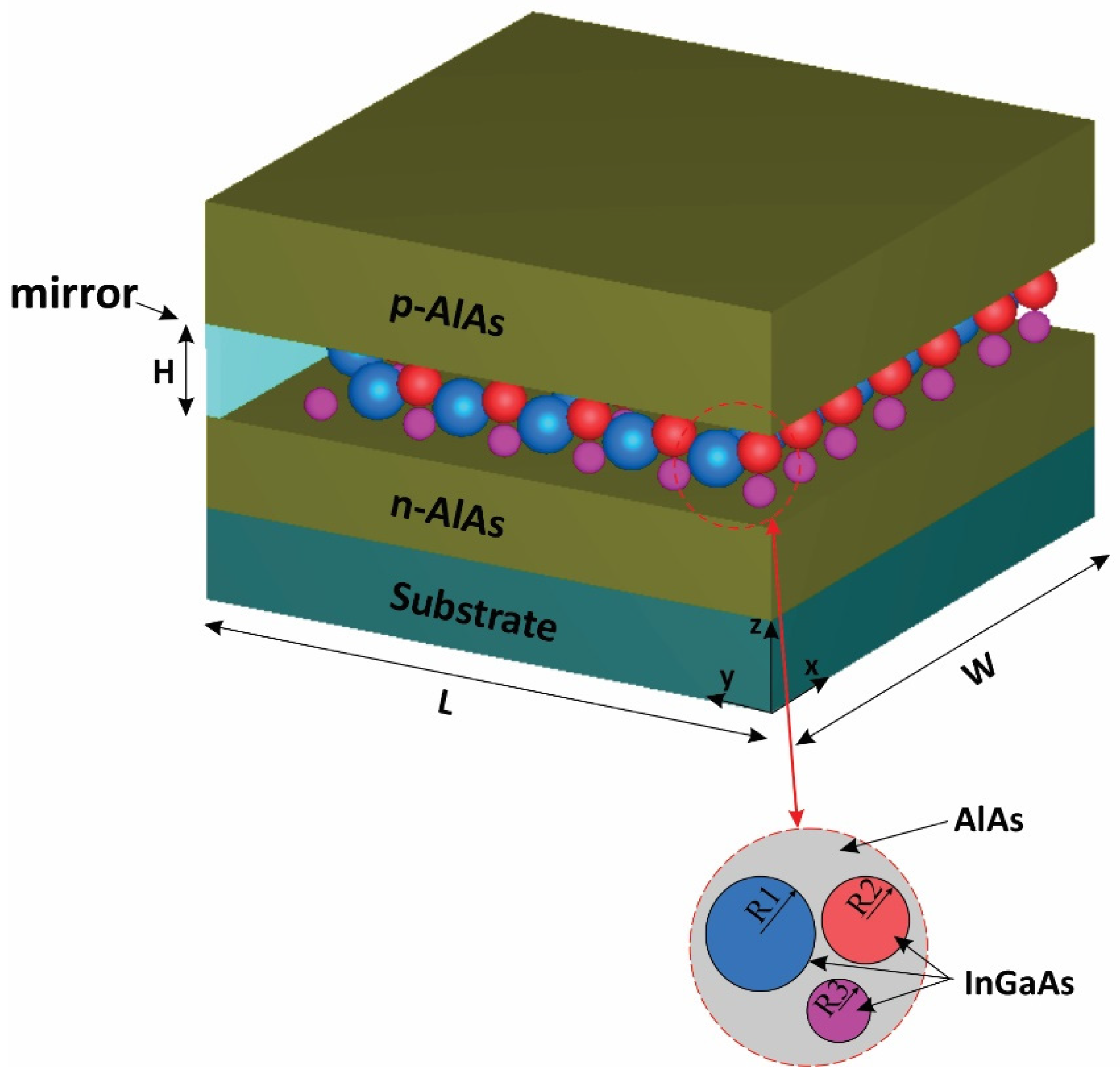
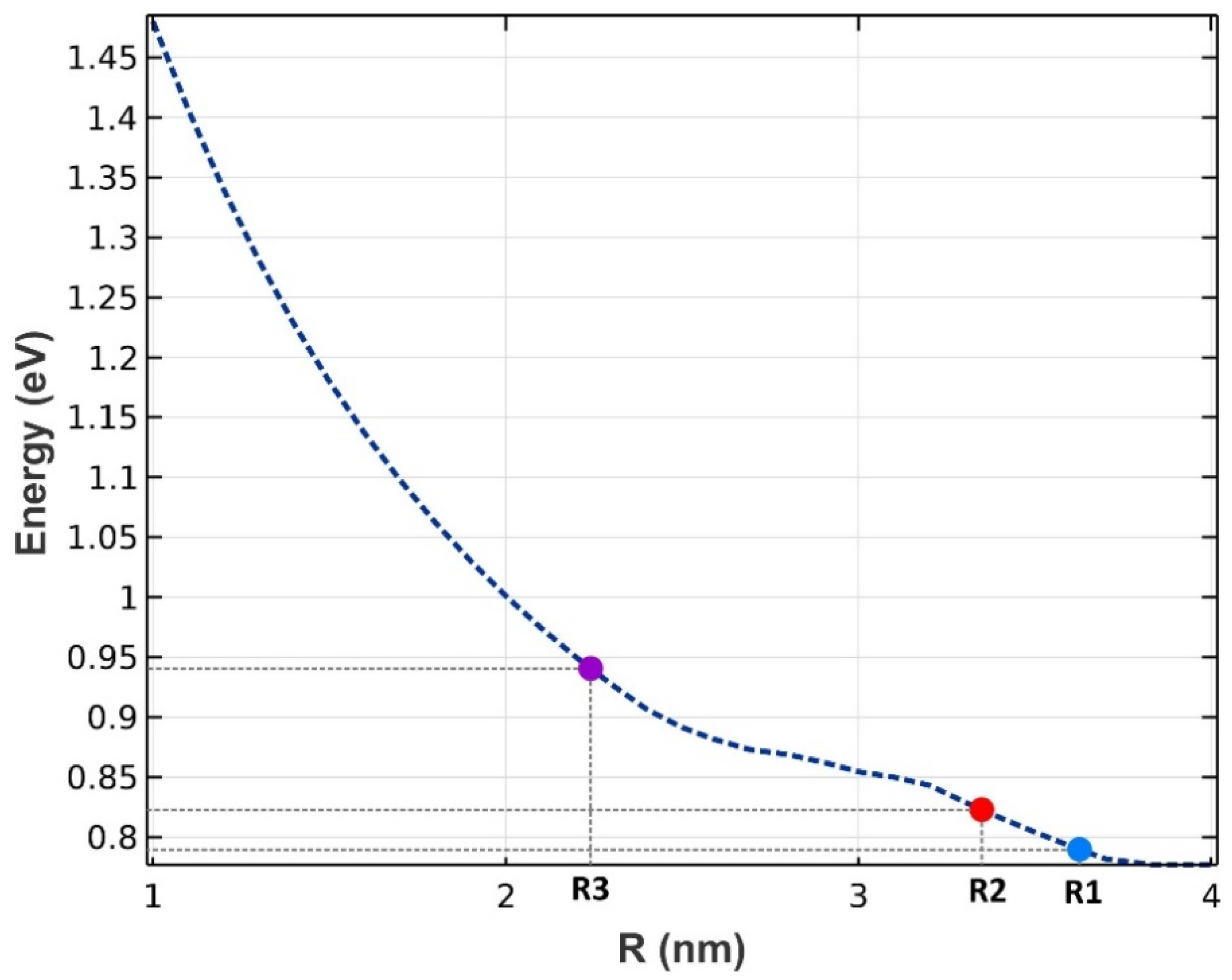
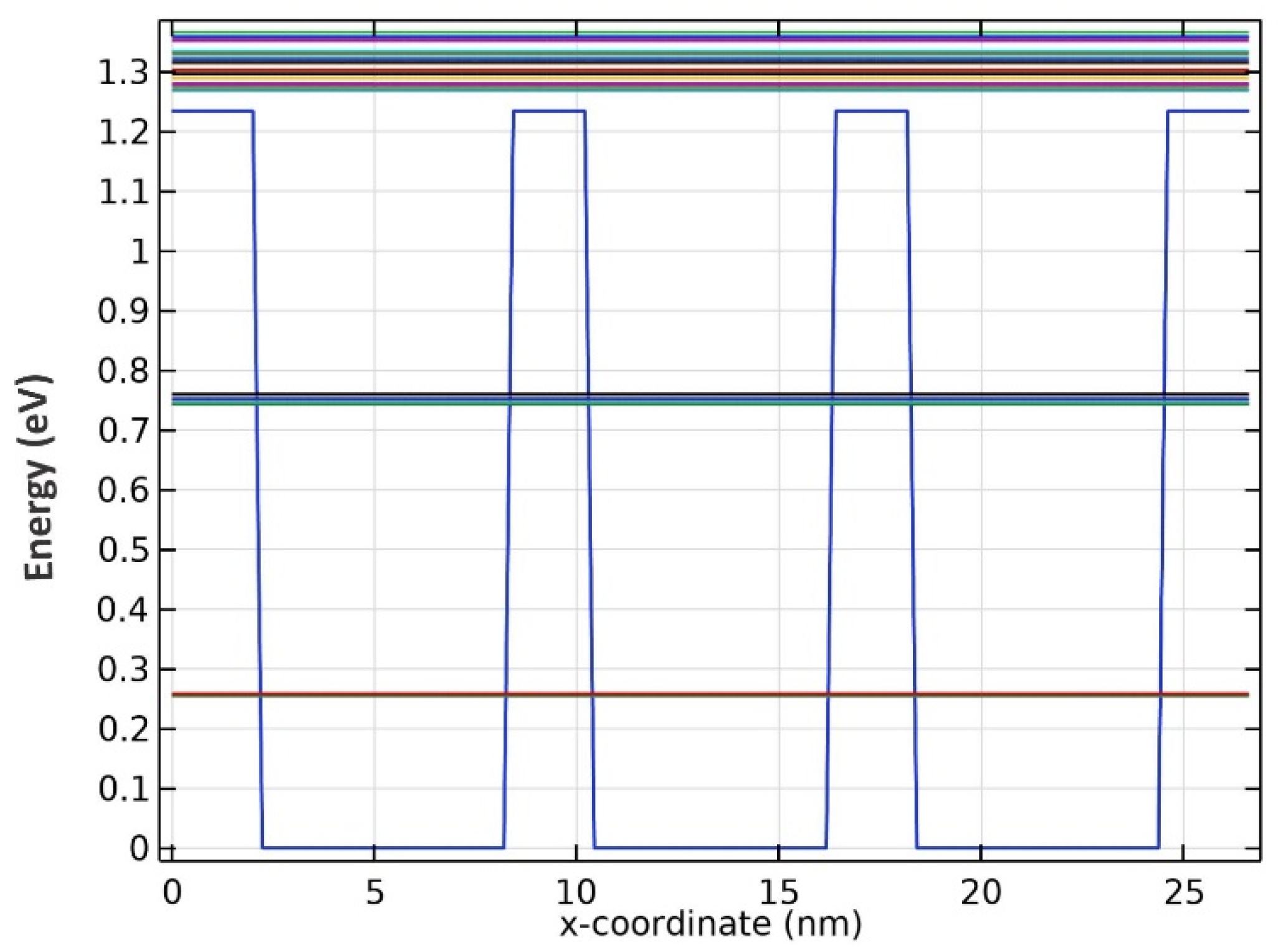


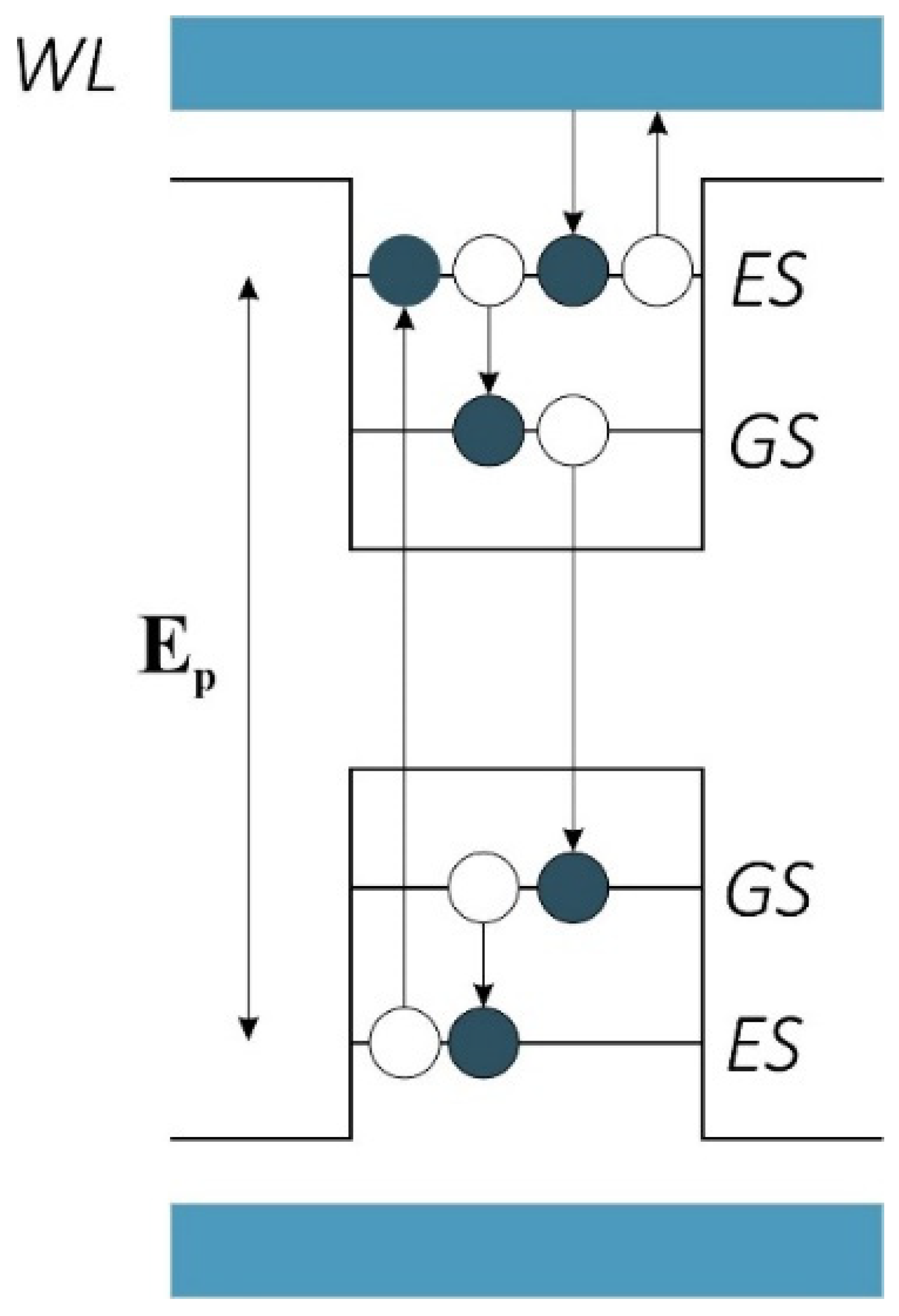
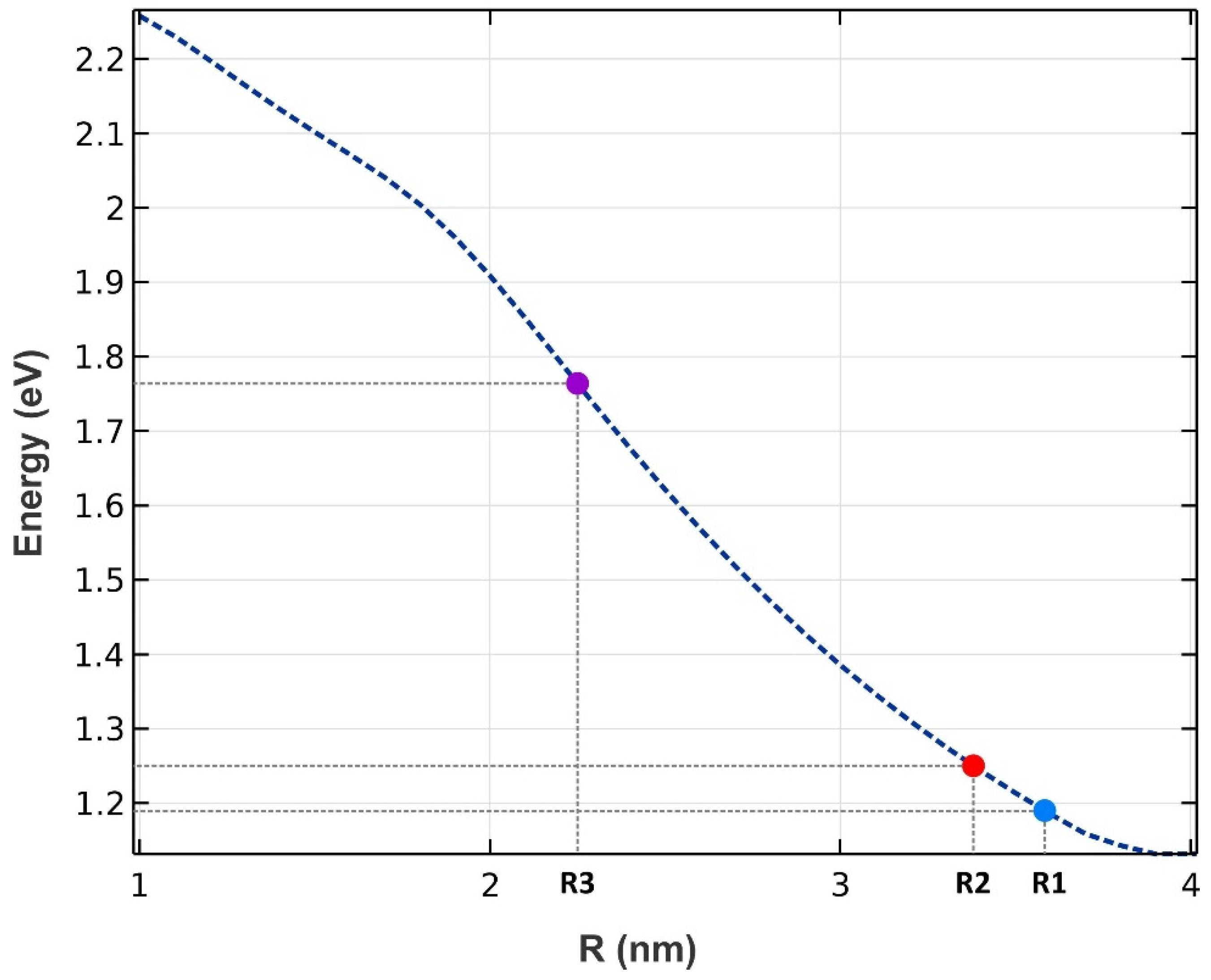
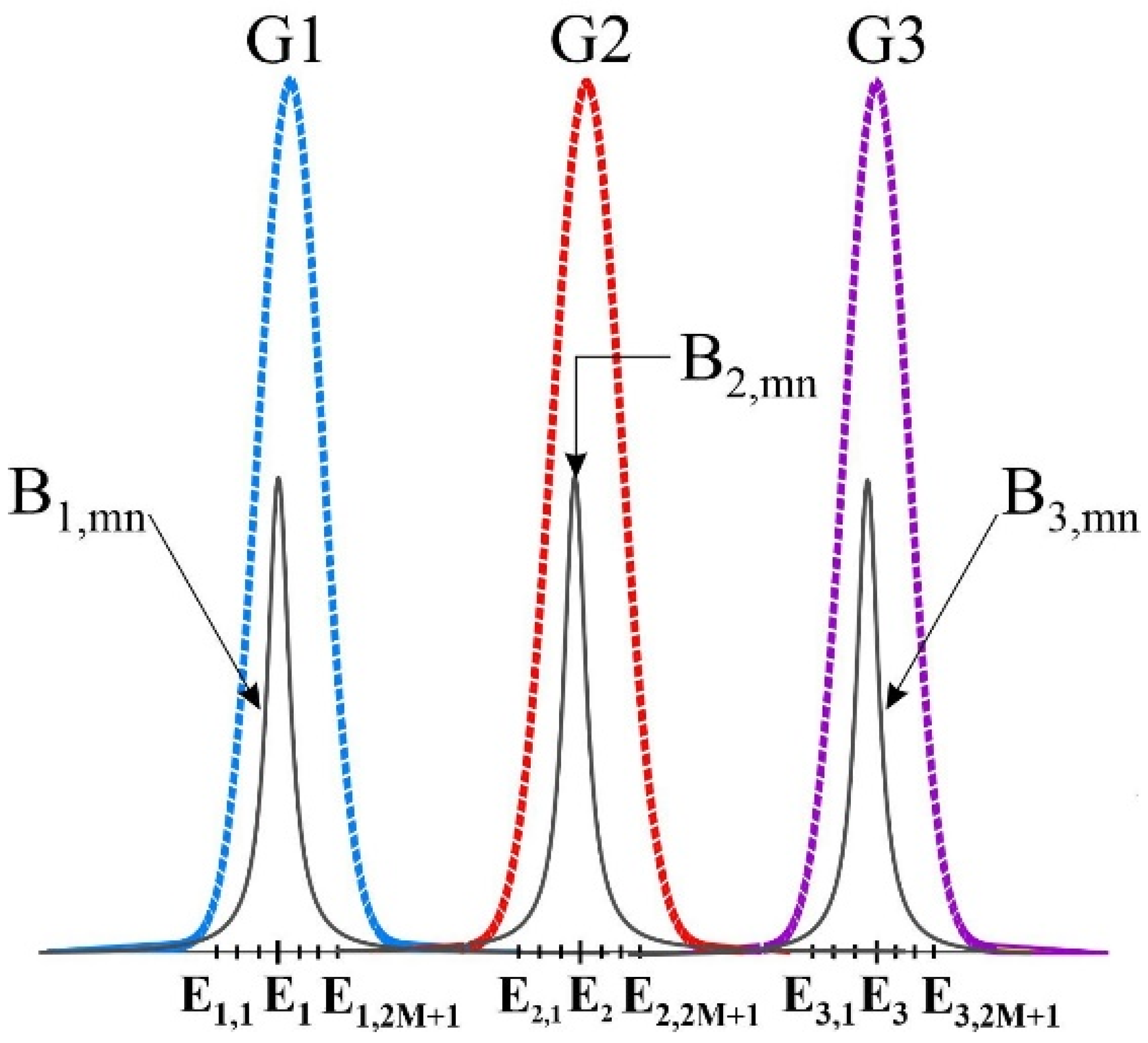

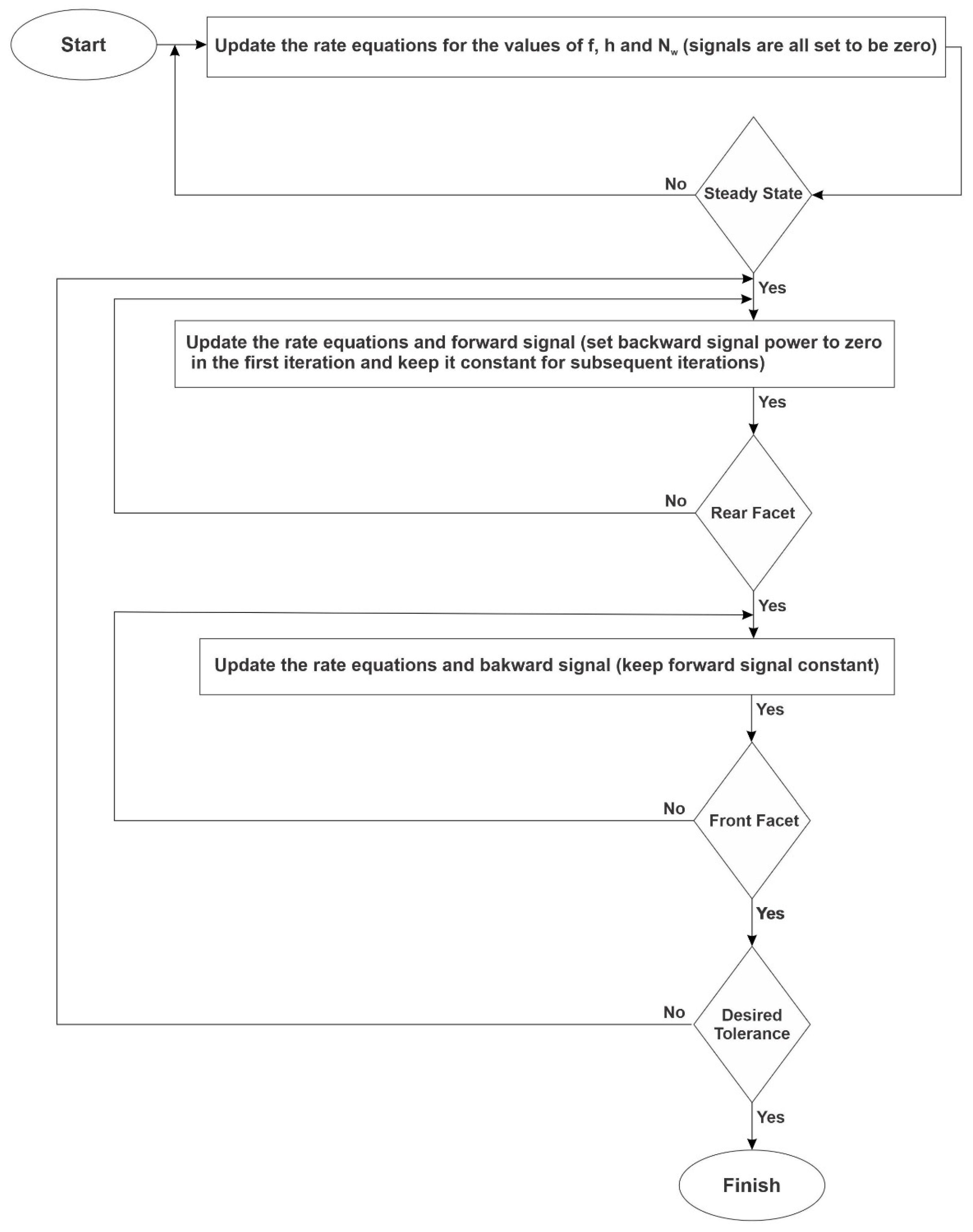
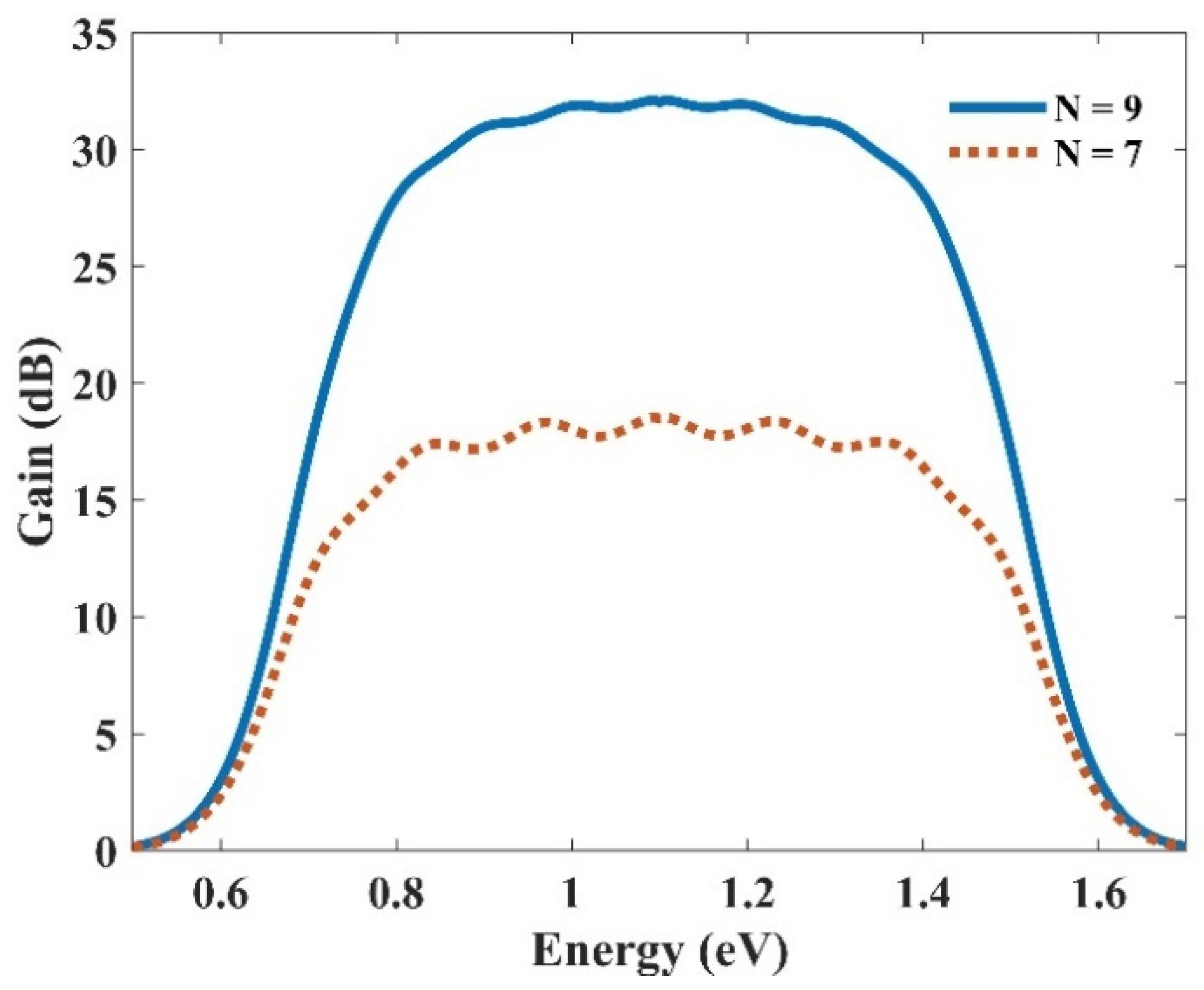
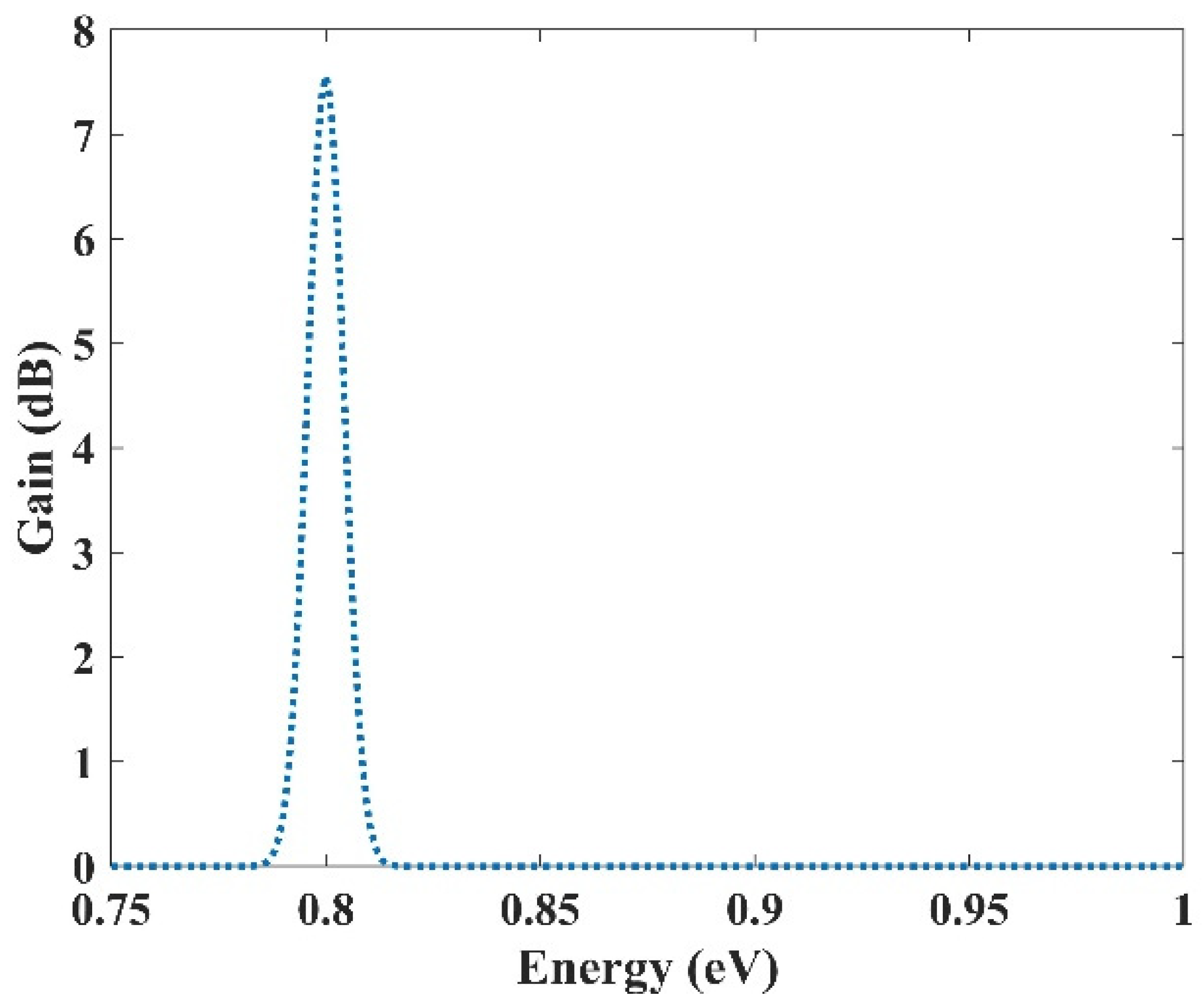

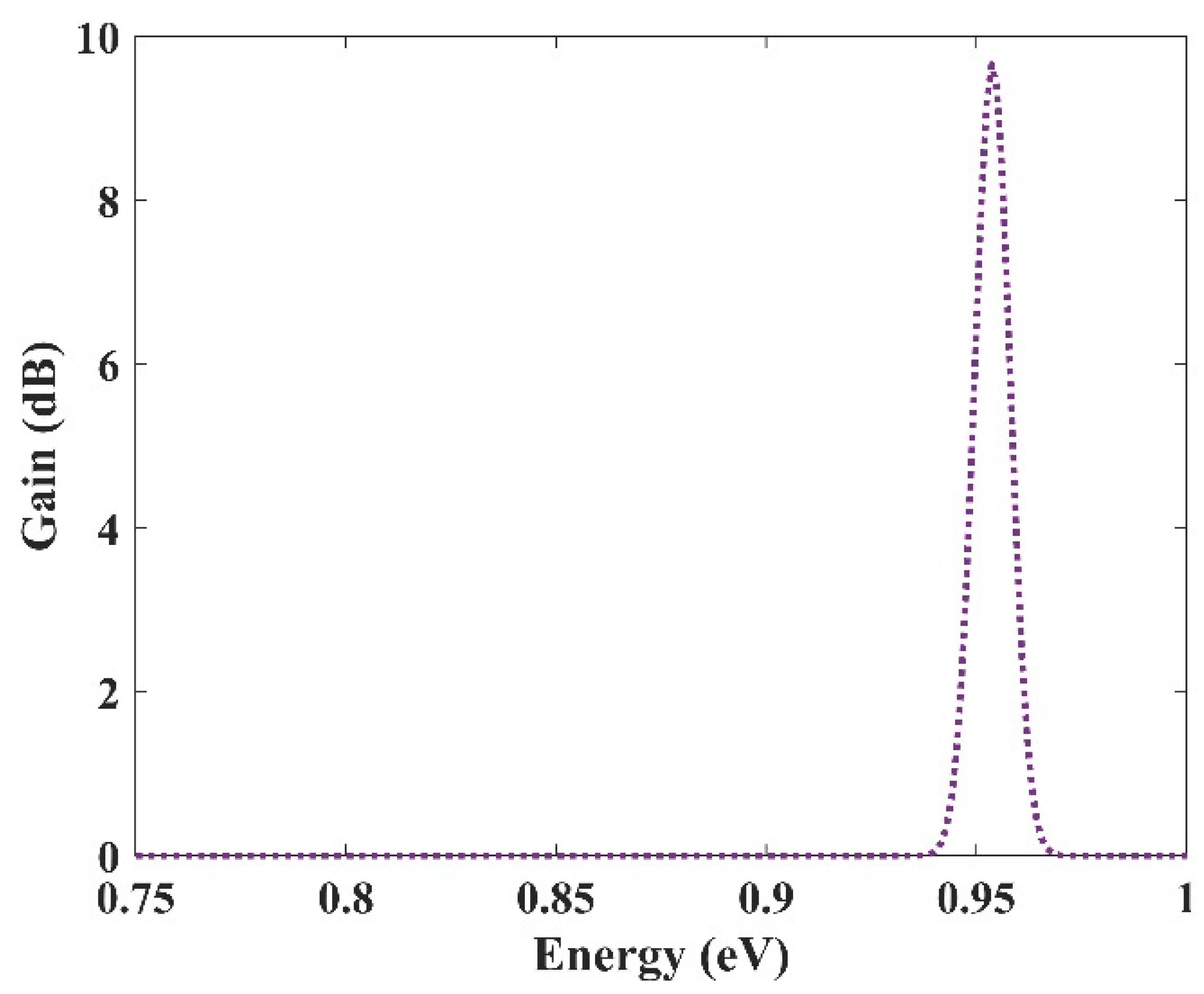

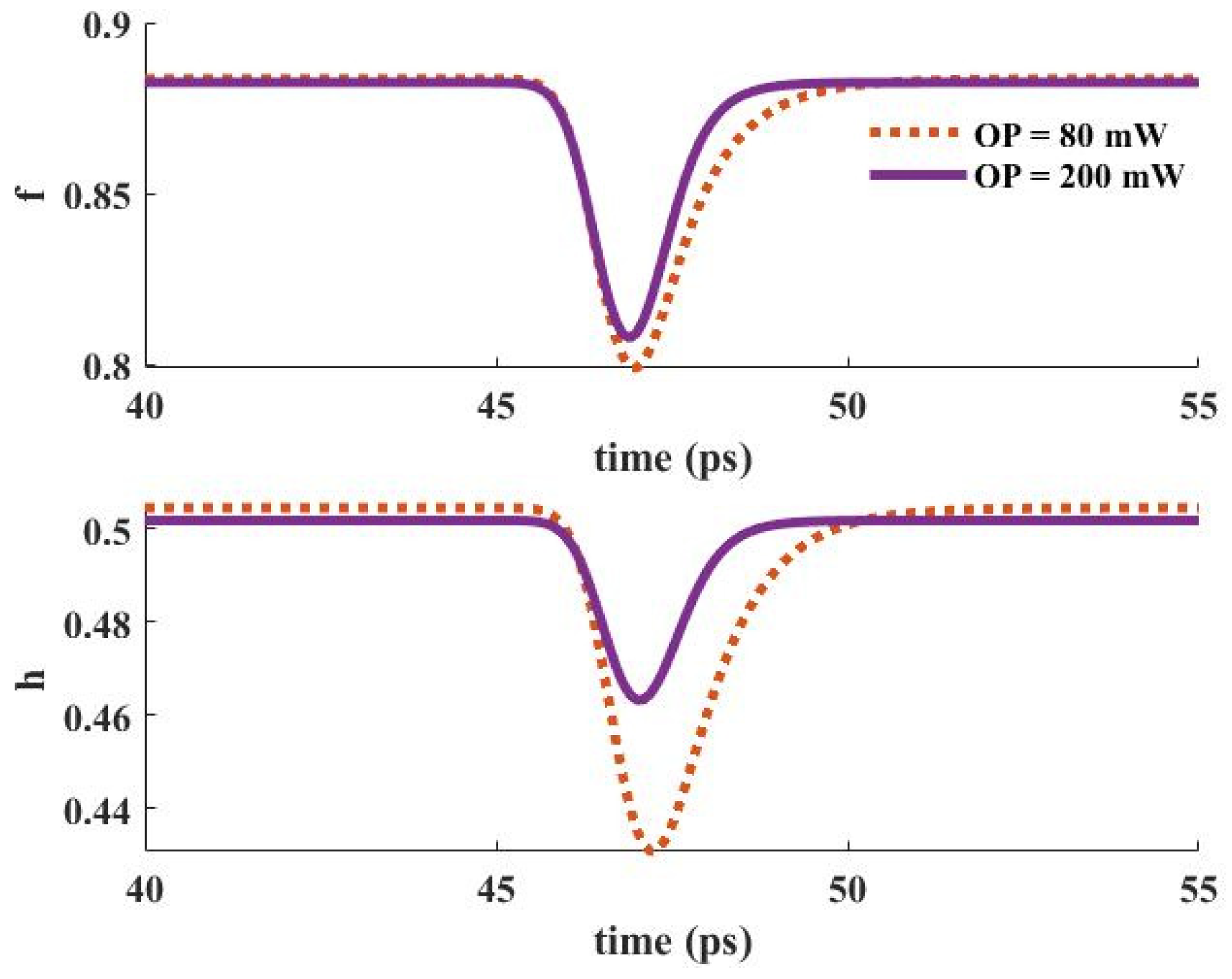
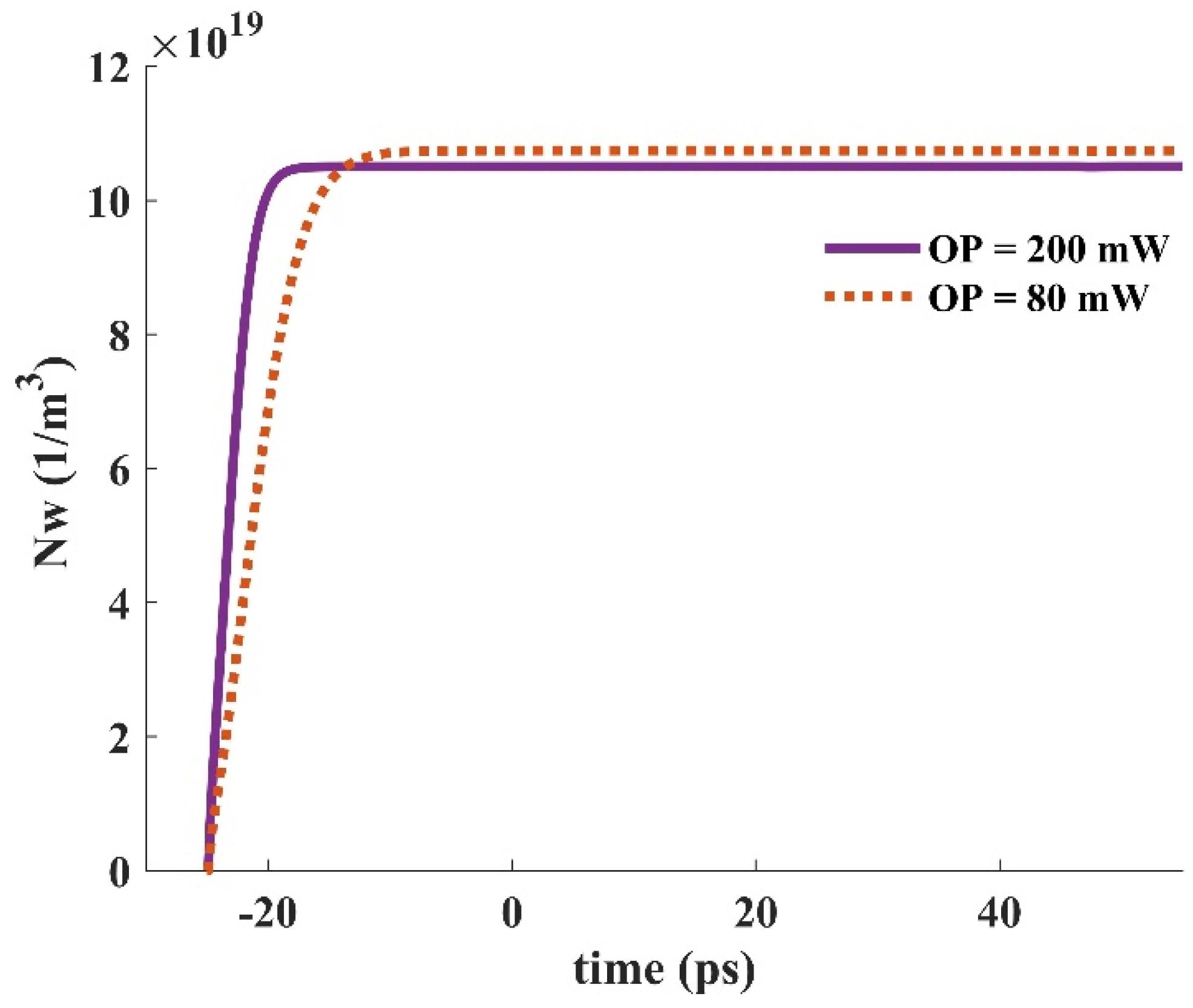
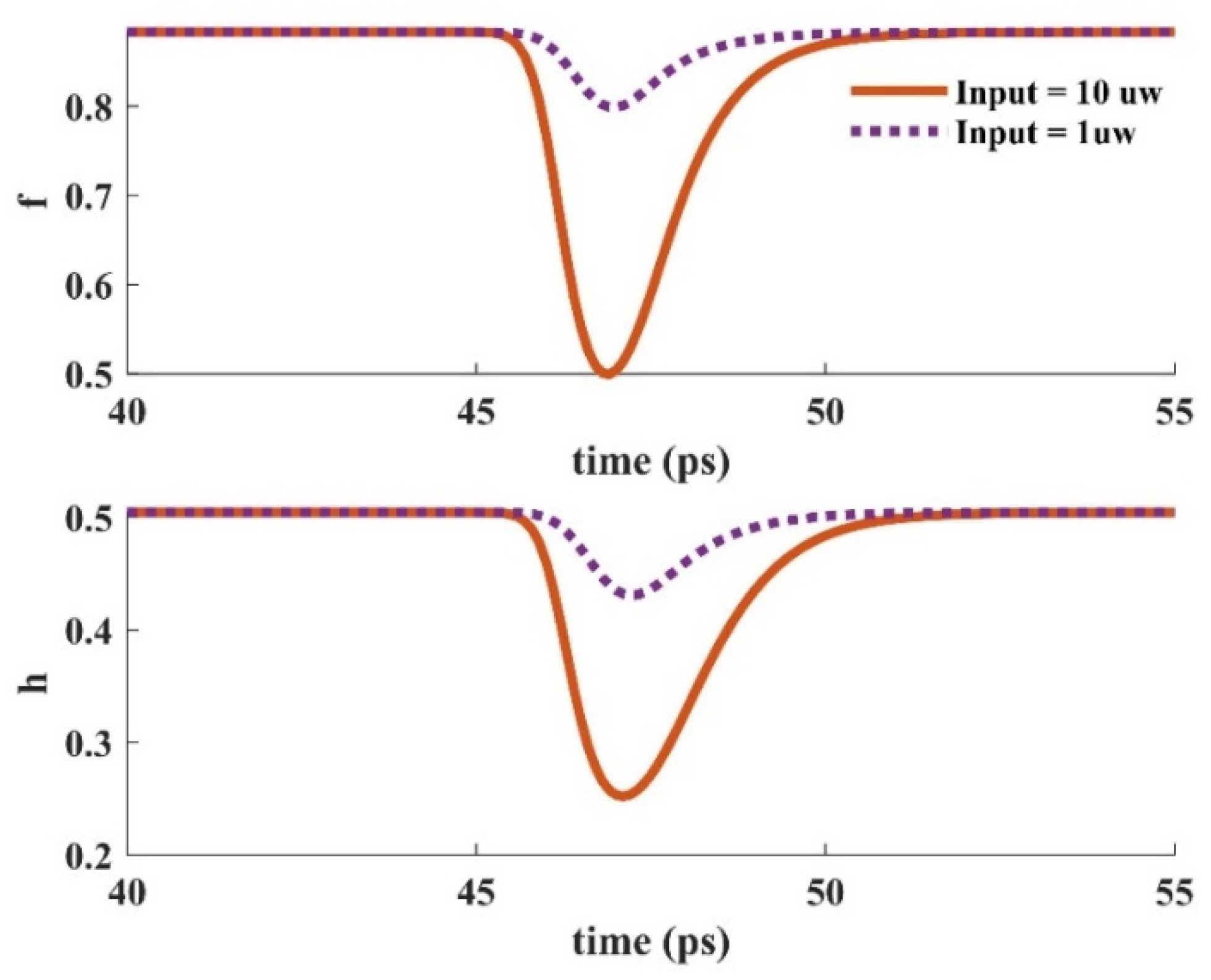

| Symbol | Value | Description |
|---|---|---|
| L | 2 mm | RSOA length |
| H | 0.25 µm | Height of the RSOA |
| W | 4 µm | Width of the RSOA |
| αmax | 1000 m−1 | The maximum modal absorption coefficient |
| αint | 200 m−1 | Material absorption coefficient |
| τw−r | 1.4 ns | Recombination lifetime for WL |
| τg−r | 2.8 ns | Recombination lifetime for GS |
| τe−r | 2.8 ns | Recombination lifetime for ES |
| τw−e | 2 ps | Relaxation lifetime from WL to ES |
| τe−w | 1 ns | Escape lifetime from ES to WL |
| τe−g | 3 ps | Relaxation lifetime from ES to GS |
| τg−e | 20 ps | Escape lifetime from GS to ES |
| De(g) | 4 (2) | Degeneracy rate of ES (GS) |
| nr | 3.5 | Refractive index |
| R | 0.8 | Reflection of the mirror |
| Paper’s Title | Optical Bandwidth | Operation Regime |
|---|---|---|
| Wideband Gain MQW-SOA Modeling and Saturation Power Improvement in a Tri-Electrode Configuration [44] | 76 nm | 1470–1546 nm |
| A broad-band MQW semiconductor optical amplifier with high saturation output power and low noise figure [45] | 120 nm | 1450–1570 nm |
| C- and L-Band External Cavity Wavelength Tunable Lasers Utilizing a Wideband SOA With Coupled Quantum Well Active Layer [46] | 77 nm | C-band and L-band |
| Ultrabroadband reflective semiconductor optical amplifier using superimposed quantum dots [16] | 270 nm | 460–730 nm |
| Switchable Ultra-wideband All-optical Quantum Dot Reflective Semiconductor Optical Amplifier | 1000 nm | 800–1800 nm |
Disclaimer/Publisher’s Note: The statements, opinions and data contained in all publications are solely those of the individual author(s) and contributor(s) and not of MDPI and/or the editor(s). MDPI and/or the editor(s) disclaim responsibility for any injury to people or property resulting from any ideas, methods, instructions or products referred to in the content. |
© 2023 by the authors. Licensee MDPI, Basel, Switzerland. This article is an open access article distributed under the terms and conditions of the Creative Commons Attribution (CC BY) license (https://creativecommons.org/licenses/by/4.0/).
Share and Cite
Nahaei, F.S.; Rostami, A.; Mirtagioglu, H.; Maghoul, A.; Simonsen, I. Switchable Ultra-Wideband All-Optical Quantum Dot Reflective Semiconductor Optical Amplifier. Nanomaterials 2023, 13, 685. https://doi.org/10.3390/nano13040685
Nahaei FS, Rostami A, Mirtagioglu H, Maghoul A, Simonsen I. Switchable Ultra-Wideband All-Optical Quantum Dot Reflective Semiconductor Optical Amplifier. Nanomaterials. 2023; 13(4):685. https://doi.org/10.3390/nano13040685
Chicago/Turabian StyleNahaei, Farshad Serat, Ali Rostami, Hamit Mirtagioglu, Amir Maghoul, and Ingve Simonsen. 2023. "Switchable Ultra-Wideband All-Optical Quantum Dot Reflective Semiconductor Optical Amplifier" Nanomaterials 13, no. 4: 685. https://doi.org/10.3390/nano13040685
APA StyleNahaei, F. S., Rostami, A., Mirtagioglu, H., Maghoul, A., & Simonsen, I. (2023). Switchable Ultra-Wideband All-Optical Quantum Dot Reflective Semiconductor Optical Amplifier. Nanomaterials, 13(4), 685. https://doi.org/10.3390/nano13040685







